Global edible oils market is estimated to be valued at USD 244.49 Bn in 2025 and is expected to reach USD 341.97 Bn by 2032, exhibiting a compound annual growth rate (CAGR) of 4.9% from 2025 to 2032.
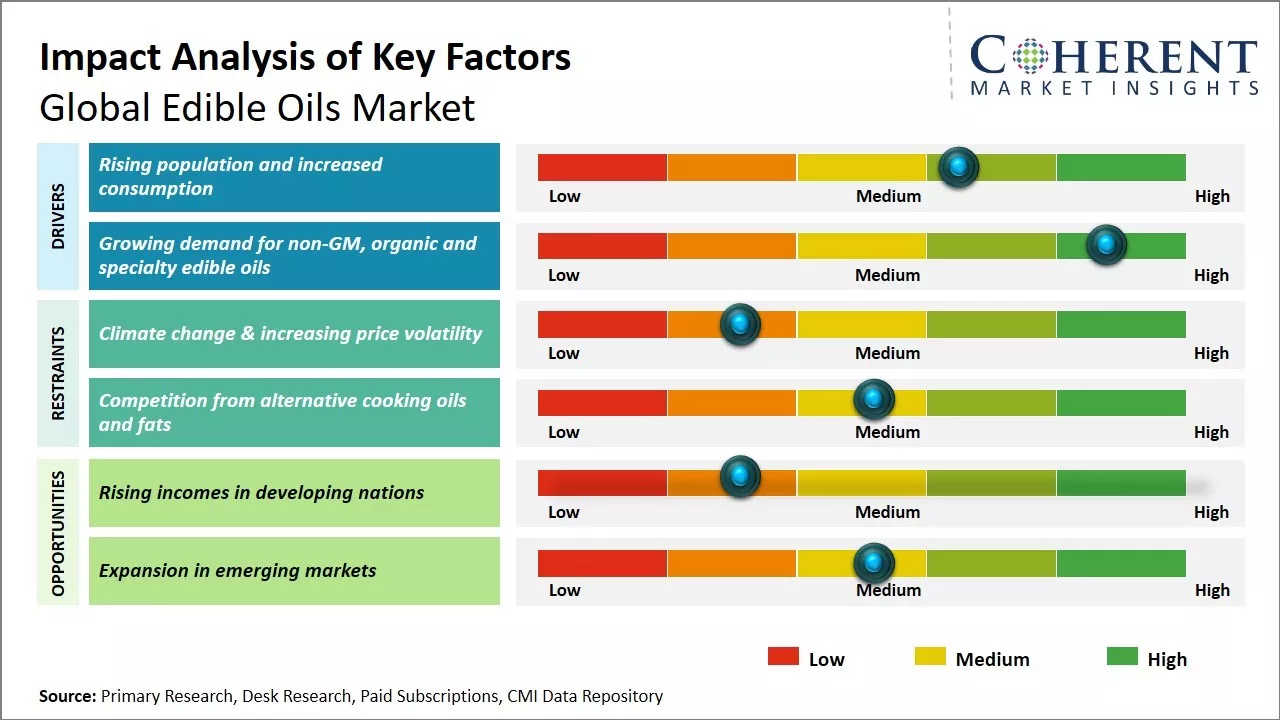
Discover market dynamics shaping the industry: Download Free Sample
Global edible oils market growth is driven by rising health consciousness among consumers and inclination towards use of plant-based edible oils like olive, sunflower and peanut oils in food preparations. Consumers are increasingly preferring healthier oil options owing to rising obesity and cardiovascular issues. Moreover, frequent product launches catering to consumer demand for novel flavors and mixes as well as effective marketing campaigns by leading players is driving the market growth. However, price fluctuations of agricultural commodities and availability of substitutes may hamper the market growth during the forecast period.
Rising population and increased consumption
Increasing global population boosts demand for food products. According to latest UN projections IN 2022, the global population is expected to reach around 8.5 billion by 2030 and 9.7 billion by 2050. This surging population will require higher food production. Edible oils serve as an important component in various culinary applications and food products. As populations grows, the consumption of food items containing edible oils is also projected to rise substantially. Developing regions which are experiencing high population growth will witness significantly higher consumption of edible oils. Increasing urbanization and changing lifestyles across major developing economies are also contributing to accelerated edible oils consumption. Since edible oils are widely used in preparing and processing various snack foods, bakery products and ready meals, their consumption will increase with the boom in packaged food retail. Moreover, rising disposable incomes expand consumer bases to include more edible oils in their diets to fulfill nutrition demands. The affluent middle class sections are increasingly incorporating premium variety oils like olive oil in cooking and meals.
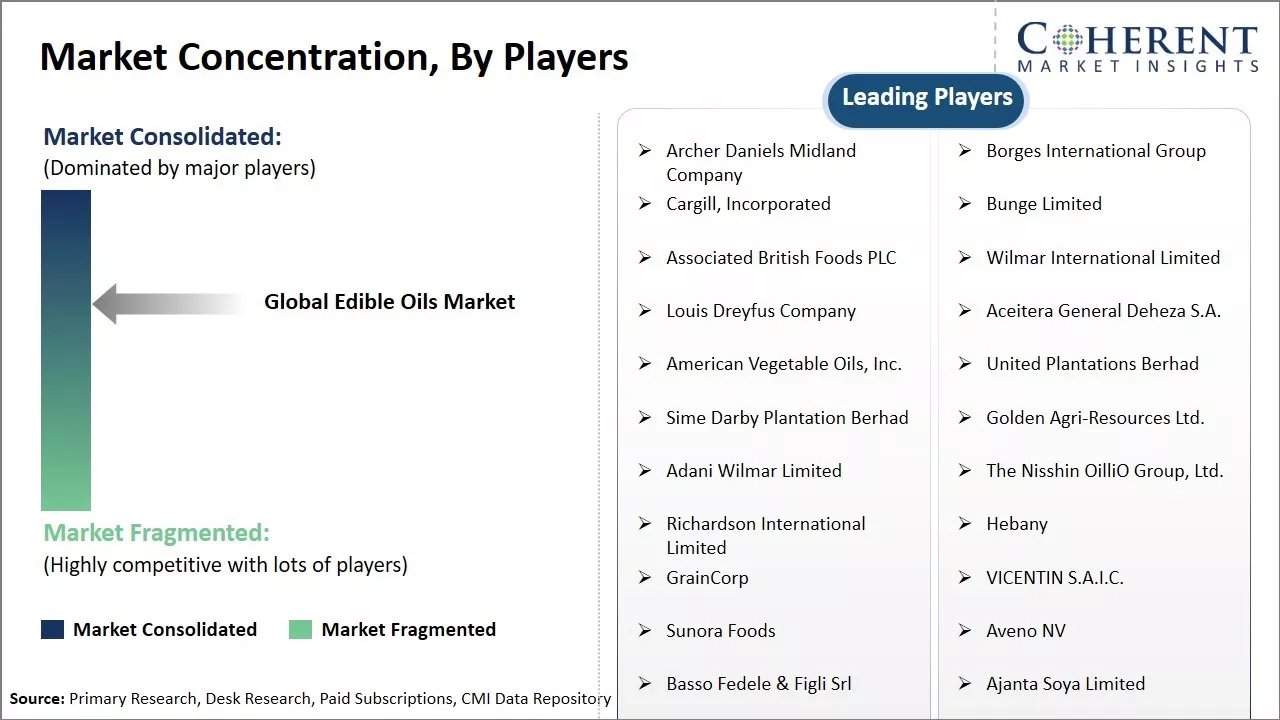
Get actionable strategies to beat competition: Download Free Sample
Growing demand for non-GM, organic and specialty edible oilsThere has been a notable shift in consumer preferences towards healthier, natural and sustainable food options. Consumer distrust over genetically modified ingredients and demands for non-GM products open lucrative opportunities for non-GM edible oil producers. Thus, the production of non-GM varieties of major edible oils like soybean, canola and sunflower oils has significantly risen. Organic edible oils tailored for health-conscious customers are gaining widespread popularity. Strict non-GMO and organic certification processes ensure premium pricing for such niche edible oil variants. Meanwhile, specialty oils extracted from exotic fruits and seeds are attracting a massive consumer base. Coconut, avocado and olive oils have emerged as popular superfood ingredients. The alleged health benefits of these oils including cardiovascular support has boosted the customer outreach. Even among developing nations, the affinity for premium imported oils is strengthening with prosperity.
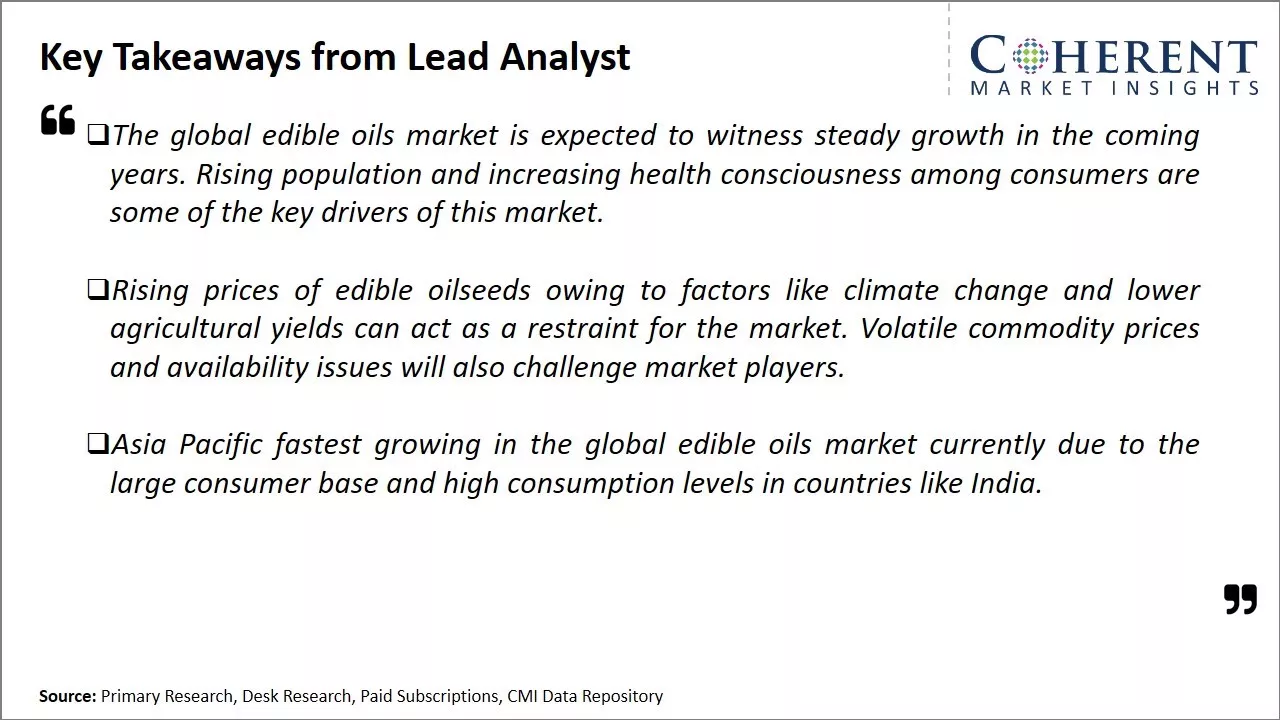
To learn more about this report, Download Free Sample
Challenges: Climate change & increasing price volatilityClimate change and volatility in price are major hurdles restraining the growth of the global edible oils market. Rising temperatures and changing weather patterns caused by climate change are negatively impacting oilseed cultivation around the world. Droughts and excessive rains are reducing crop yields, affecting the availability of edible oils. According to data from the UN Food and Agriculture Organization (FAO), the soybean crop production in Argentina declined by more than 10% between 2021-22 due to prolonged droughts. As Argentina is one of the largest soybean exporters, this has put upward pressure on global soybean prices. Similarly, palm oil production has been declining in Indonesia and Malaysia in recent years partly due to shifting rainfall patterns brought by climate change. As per data from the U.S. Department of Agriculture's Foreign Agricultural Service (FAS), Indonesia's palm oil production fell by around 3% in 2020 compared to the previous year. This lowered supplies have contributed to higher palm oil prices in the international market. The volatility in prices of edible oils poses another challenge. Geopolitical tensions, changes in government policies of major producing countries, and fluctuations in currency exchange rates often result in sharp swings in the prices of edible oils like soybean, canola and sunflower oils. According to data from leading NGO ActionAid, sunflower oil prices rose by over 50% in Europe between February-May 2022 alone due to uncertainties arising from the Russia-Ukraine conflict. Such frequent and steep price shocks discourage food manufacturers from investing and undermine consumer demand, hampering the growth potential of the edible oils industry.
Opportunities: Rising incomes in developing nations
Rising incomes in developing nations present a great opportunity for growth in the global edible oils market. As per capita incomes rise, consumers in developing countries are able to spend more on foods that were previously unaffordable. This allows for higher demand of edible oils such as soybean, sunflower, and canola oils which are seen as more premium options compared to traditional oils such as palm and coconut oil. A direct consequence of increasing incomes is changes in dietary patterns and food consumption habits. People shift away from basic staple-based diets to more varied diets that include higher amounts of meat, dairy and baked goods. This increases the demand for edible oils as they are widely used for cooking various food items as well as in many processed food products. The growing middle class in large developing nations of Asia, South America, Middle East and Africa regions have more disposable incomes to spend on better quality edible oils. According to data from United Nations World Food Programme, the prevalence of undernourishment in developing countries declined from 23.3% in 2015 to 19.3% in 2020 before the pandemic. This indicates more people had access to adequate calorie intake and nutrition. With continued economic growth projected in coming years, the negative impact of COVID-19 on incomes is expected to be temporary. More people will join the consuming class in developing worlds which will support strong growth in edible oils market.
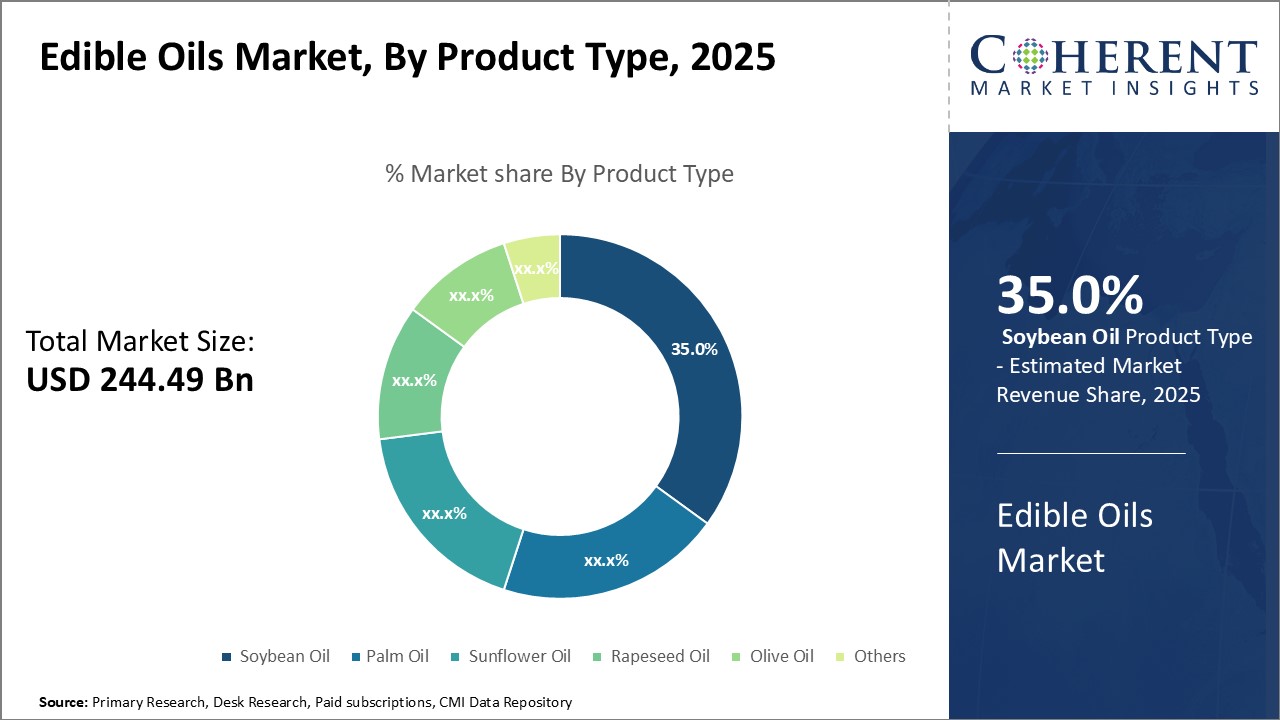
Discover high revenue pocket segments and roadmap to it: Download Free Sample
Insights, By Product Type: Nutritional Advantage Boosts Demand for Soybean OilIn terms of product type, soybean oil segment is estimated to contribute the 35.0 % share of the market in 2025, owing to its nutritional advantage over other oils. Soybean oil is considered one of the healthiest cooking oils due to its high concentration of polyunsaturated and monounsaturated fatty acids. It contains no cholesterol and is low in saturated fat. The Omega-3 and Omega-6 fatty acids in soybean oil help support heart and brain health when consumed as part of a balanced diet. It is commonly recommended by dietitians and nutritionists Consumers are increasingly seeking oil products that provide nutritional benefits rather than just flavor. Research continues to reinforce soybean oil's role in a heart-healthy diet. Agriculturally, soybean is one of the most versatile crops and widely cultivated worldwide.
Insights, By Packaging Type: Pouches Emerge as Popular Packaging Format
In terms of packaging type, pouches segment is estimated to contribute the 34.1% share of global edible oils market in 2025, due to their growing popularity among consumers. Pouches offer several advantages over traditional packaging formats like bottles and cans. These take up less physical space which appeal to urban customers with smaller living spaces. Pouches are also lightweight and easy to handle, making them more portable for on-the-go lifestyles. The pouch format allows innovative bag-in-box packaging solutions that help prevent oil wastage and mess during filling. Pouches can better maintain oil freshness through improved barrier technology. Some self-standing pouches even enable easier dispensing and pouring of oil without needing an additional container. These user-friendly features are driving more consumers, especially young professionals and families, to choose oils in pouches. All these factors have made pouches the ideal format to ride the global edible oils industry growth.
Insights, By Distribution Channel: Offline Channels Sustain Edible Oils Demand
In terms of distribution channel, offline segment including supermarkets, convenience stores and independent groceries is estimated to contribute the 62% share of the global edible oils market in 2025 due to embedded buying behaviors and certain limitations of new distribution formats. Grocery shopping remains a social activity for many consumers worldwide. Supermarkets provide a one-stop browsing and purchasing experience alongside other household staples. Their widespread presence ensures easy access particularly in suburban and rural regions with underdeveloped digital infrastructure. Store promotions and aisles additionally influence last-minute top-up buying. Online channels are growing rapidly but edible oil represents a relatively bulky and perishable product that benefits less from e-commerce logistics as compared to packaged foods or cosmetics. Limited payment options and tech-readiness continue restricting the addressable market for online edible oils in some regions
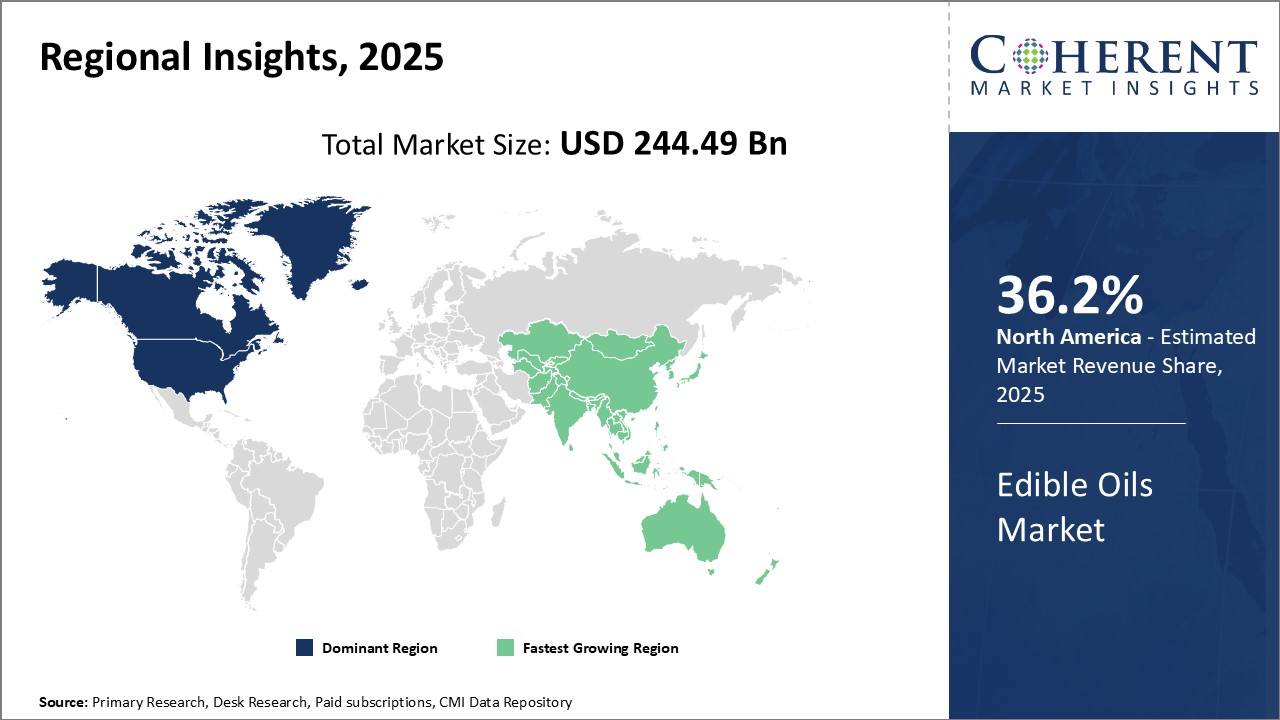
Need a Different Region or Segment? Download Free Sample
North America has been dominating the global edible oils market for the past few decades with estimated 36.2% share in 2025. The large population, rising disposable incomes, and growing fast food culture have boosted demand for edible oils, especially soybean and canola oil. The U.S. is the single largest consumer market, accounting for over 40.5% of global soybean oil consumption. It is also the leader in canola oil production and trade. Strong agriculture and food processing industries have enabled North American companies to achieve scale and integration across the supply chain for edible oils. Leading producers and traders based in the region have established global footprint to tap high-growth overseas markets.
Asia Pacific has emerged as the fastest growing regional market for edible oils in recent years. Rapid population expansion, rising affluence, and changing dietary preferences are driving extraordinarily high volumes. Indonesia has one of the largest palm oil industries in the world. It is the top producer as well as exporter, meeting over 50.5% of global palm oil demand. India is also a dominant player and relies heavily on imports. The South Asian giant imports over 15 million tons of edible oils annually, more than any other country. Major cooking oils popular in Asia Pacific include soybean, palm, and canola oils. Developing nations in Southeast Asia are showing immense promise due to growth in food production and processing sectors.
Edible Oils Market Report Coverage
| Report Coverage | Details | ||
|---|---|---|---|
| Base Year: | 2024 | Market Size in 2025: | USD 244.49 Bn |
| Historical Data for: | 2020 To 2024 | Forecast Period: | 2025 To 2032 |
| Forecast Period 2025 to 2032 CAGR: | 4.9% | 2032 Value Projection: | USD 341.97 Bn |
| Geographies covered: |
|
||
| Segments covered: |
|
||
| Companies covered: |
Archer Daniels Midland Company, Borges International Group, Cargill, Incorporated, Bunge Limited, Associated British Foods PLC, Wilmar International Limited, Louis Dreyfus Company, Aceitera General Deheza S.A., American Vegetable Oils, Inc., United Plantations Berhad, Sime Darby Plantation Berhad, Golden Agri-Resources Ltd., Adani Wilmar Limited , The Nisshin OilliO Group, Ltd., Richardson International Limited, Hebany , GrainCorp, VICENTIN S.A.I.C. , Sunora Foods, Aveno NV , Basso Fedele & Figli Srl, Ajanta Soya Limited |
||
| Growth Drivers: |
|
||
| Restraints & Challenges: |
|
||
Uncover macros and micros vetted on 75+ parameters: Get instant access to report
Share
Share
Missing comfort of reading report in your local language? Find your preferred language :
Transform your Strategy with Exclusive Trending Reports :
Frequently Asked Questions
Joining thousands of companies around the world committed to making the Excellent Business Solutions.
View All Our Clients